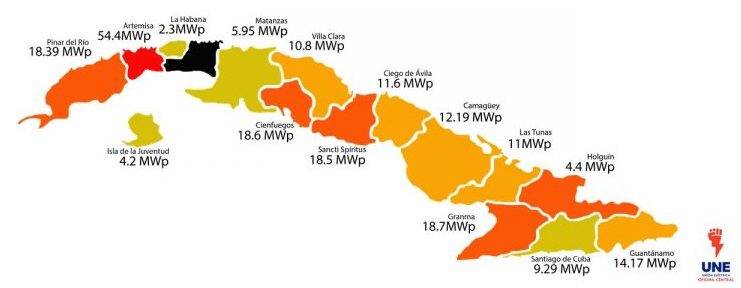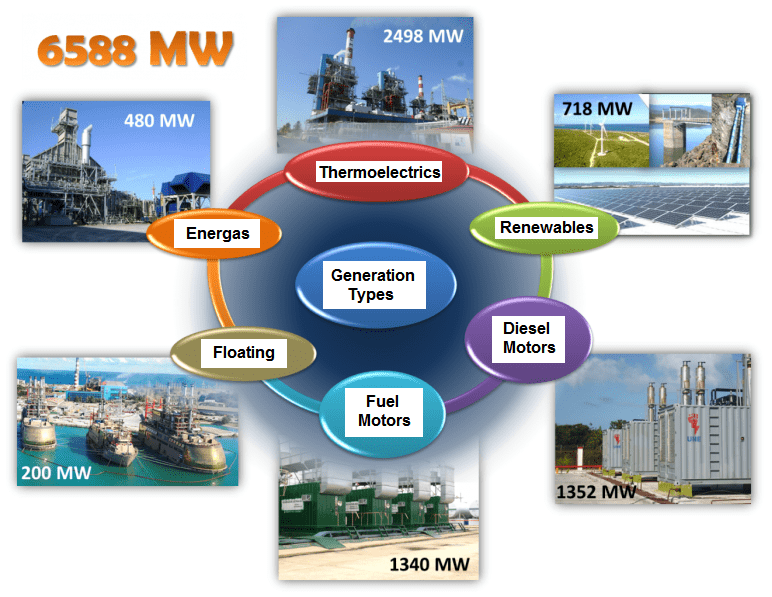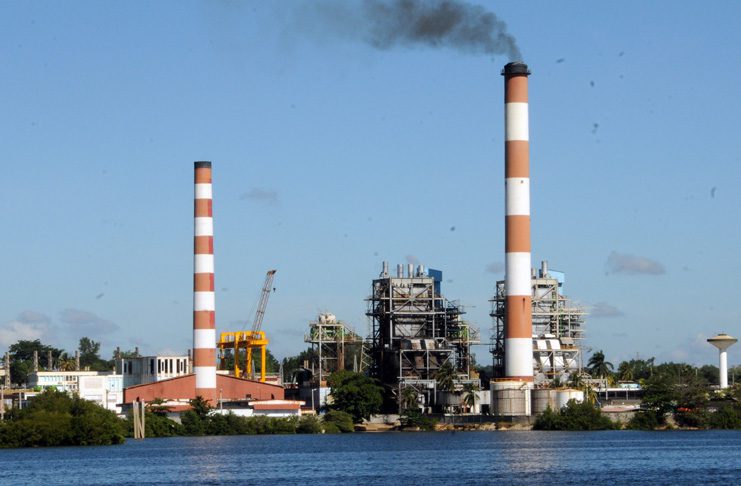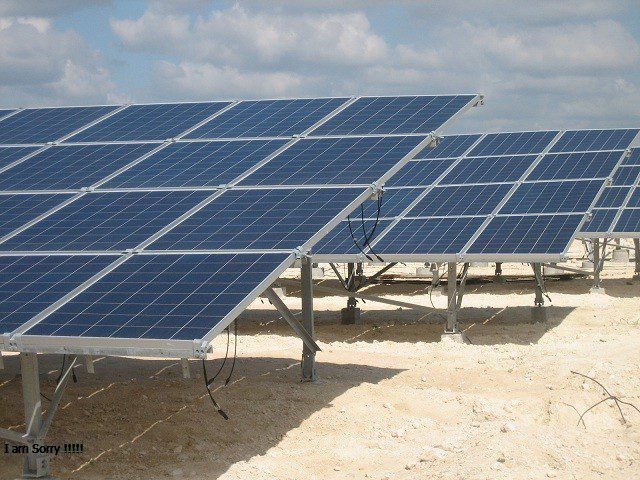Current Generation Capacity, Future Investment Plans, and Photovoltaic Projects of the Cuban Energy Industry
Credit to Author: POWER| Date: Mon, 14 Feb 2022 20:13:59 +0000

The state-owned Unión Eléctrica (UNE) is responsible for supplying electricity to the Cuban population and the national economy. This is a complex process in which more than 50,000 workers intervene, highlighted Jorge Armando Cepero Hernández, UNE’s general director during a recent press conference. The executive explained that electrical energy is produced with a generation fleet that has more than 6,500 MW installed (Figure 1).

“Of these, 480 MW of combined cycle technology that uses the accompanying gas produced from the extraction of national crude oil as a fuel,” he said. This is the cheapest generation in the country and its facilities treat the gas, which is used then for food cooking in some regions of Havana city.
Another important component of the National Grid (NG) is the 2,498 MW coming from thermal generation that produces approximately 60% of the country’s generation. “This is a technology that has more than 36 years of exploitation on average, which requires a great effort to maintain its availability,” explained Cepero Hernández.
Likewise, there are about 2,700 MW in both fuel and diesel motors distributed throughout the country. “This generation was installed as of 2005 as part of the Energetic Revolution, which is of vital importance in the confrontation of weather events in order to restore the electricity supply to the people as quickly as possible,” he said.
Cepero Hernández announced that since 2019 the country has relied on the contribution of three thermal power barges, with a total capacity of 200 MW, from the Turkish company Karadeniz Holding, which use low-quality fuel and have high operational availability, which makes it a generation that is economically feasible for the NG.
“And we must mention the generation that will undoubtedly be the future and the fundamental basis of the country’s generation: renewable sources (RS). At present, they produce 4.5% of the total generation, but is estimated to be the sector with the highest growth because it reduces the consumption of fossil fuels and has a positive environmental impact,” said Cepero Hernández.
In this sense, the UNE’s vision is to accelerate the incorporation of RS into generation and gradually reduce the consumption of fossil fuels, which is currently close to 5 million tons, of which close to half is imported that is expensive for the country. The purpose is to achieve 100% generation from this RS in the future.
“This purpose also contributes to the country’s energy independence since 53% of the current generation is accomplished with imported energy sources. To optimize the cost of the MWh generated with the available sources, the National Load Office (NLO) carries out a daily planning and scheduling of the generation using computer tools developed in Cuban universities, and that guarantee to achieve this objective and operate the national electric system in a safe manner,” said Cepero Hernández.
How Is Demand Covered in Cuba Today?
In another moment of the press conference, the general director of the UNE explained that to cover the demand, all generation sources are needed, and “these are incorporated to the extent that the national consumption requires, and is carried out from the most economical way to the least economical.”
He also said that the NLO is the one that governs the entire system and delivers the electric energy depending on the demands. “It is decided when, how, and which places need more or less electricity,” he explained.
“The night peak is the time of the day when diesel is consumed the most, so we suggest to the entire population to take measures in order to control electricity consumption, because it affects the family economy and causes the country to spend high amounts of foreign currency for the purchase of diesel fuel,” emphasized the executive.
He also pointed out that the generated electricity must be transmitted through more than 7,700 kilometers of transmission lines of 110 kV and 220 kV. Subsequently, they are distributed through more than 53,000 kilometers of distribution networks that are directly served by the provincial electricity companies, which are the ones that work more directly with the population to guarantee the service and in the billing of electricity. “The qualification of the personnel has allowed us to restore electricity service very soon despite the impact of meteorological events,” he underlined.
Eight Plants Guarantee Thermal Generation in the Country
In another segment of the press conference, Edier Guzmán Pacheco, director of Thermal Generation at UNE, commented that 2,498 MW are installed in thermal generation in eight thermoelectric plants distributed throughout the country. The plants are:
- The Máximo Gómez thermoelectric plant (TP), located in Mariel, Artemisa province, currently has three units of 100 MW each with technology from the former Soviet Union. At this plant, the rehabilitation of a 100-MW unit is being completed. This plant has the possibility of consuming national crude, which contributes to the country’s energy independence.
- The Otto Parellada TP, located in the country’s capital (Havana city) has an installed capacity of 60 MW with technology from the former Czechoslovakia (current Czech Republic), which has the benefit of being close to consumption, thus contributing to reduce electricity losses.
- The Ernesto Guevara TP, located in the municipality of Santa Cruz del Norte in the province of Mayabeque, has three units of 100 MW each of Soviet technology that can also consume domestic crude fuel, with the advantage that it is supplied through an oil pipeline, which reduces fuel transportation costs.
- The Antonio Guiteras TP, situated in the province of Matanzas, has the largest generating unit in the country with a capacity of 330 MW of French technology. This block consumes national crude that is received through a pipeline and is the most efficient power plant of the country.
- The Carlos Manuel de Céspedes TP, in the province of Cienfuegos, with two units of 158 MW each of Japanese technology, is the most reliable power plant and can receive fuel by pipeline from the Cienfuegos refinery. They are set for burning national crude fuel, although it regularly consumes fuel oil (Figure 2).
- The Diez de Octubre TP, in the municipality of Nuevitas in Camagüey province, with three units of 125 MW each and a technology manufactured in the former Czechoslovakia.
- The Lidio Ramón Pérez TP, in Felton at the province of Holguín, with two units of 250 MW of power each with technology from the former Czechoslovakia.
- The Antonio Maceo TP, on the Renté peninsula in Santiago de Cuba province, has four units of 100 MW of power each with technology from the former Soviet Union. These units also consume domestic crude oil.

Incorporate 460 MW of Power into the Electric System, Objective of the Investments
Later, Guzmán Pacheco pointed out that the main investments currently being made in thermal generation (or in conventional generation as it is known), are related to the incorporation into the NG of 460 MW of power, framed in three blocks in three different thermoelectric plants. The plants are:
- Block 5 of Antonio Maceo Thermoelectric Plant, Renté 5, of 100 MW.
- Block 1 of the Lidio Ramón Pérez Thermoelectric Plant, Felton 1, with 260 MW.
- Block 6 of Máximo Gómez Thermoelectric Plant, Mariel 6, with 100 MW.
Guzmán Pacheco explained that in the case of Renté 5, its maintenance began in March 2019, and covered the basic equipment: boiler, turbine, generator, transformer, and auxiliary equipment.
“The critical route was to repair the turbine due to wear and deformation in the low-pressure cylinder bearings and elements owing to the years of operation. We had to carry out volumes of work never carried out before in the country, which led to the total dismantling of the turbine, and then its reassembly, strictly complying with the manufacturer’s standards,” he said.
The manager explained that this repair required the investment of 22.8 million Cuban pesos, and about $950,000 in import resources. “At the end of December 2020, its repair was completed and the block was synchronizing on January 7, 2021, thus starting the test and commissioning period, which ended on February 26, 2021.” As he specified, this block will contribute to the NG about 500 GWh per year, using national fuel, which will allow the country to reduce the acquisition of imported diesel fuel.
In the case of the investment made in Block 1 of the Lidio Ramón Pérez Thermoelectric Plant, Felton 1, it was due to the occurrence of a major breakdown in the engine room area, specifically in the turbo-generator “with a total impact on the turbine and its electrical and automatic system, being permanently disabled for operation on October 24, 2016.”
“This block is the second with the highest unit power in the country, in addition to its strategic location, it is the one that ensures directly and in large extent the production of nickel in the east of Holguín province, as well as other fundamental mechanical and smelting industries in the eastern zone,” Guzmán Pacheco said.
He also revealed that, with the rapid and timely management of financing, it was possible to contract the necessary resources for the manufacture of the equipment and to carry out the assembly works of the block. Thus, the amount of this investment in import resources was €75 million.
“The block will use national crude oil. It will be supplied from the same supply sources currently available. While the capacity of the unit to be installed will be 260 MW, that is, the new turbine achieves greater efficiency and increases its design power by 10 MW to work in base regime, with an expected service life of 25 years. The energy produced in one year will be 1,537.4 GWh, which is equivalent to consuming 377,000 tons of crude oil,” he said.
Guzmán Pacheco explained that due to the epidemiological situation created by COVID-19, as of March 2020, the incorporation of foreign technical assistance for the assembly and testing of equipment onsite has been affected.
“Currently the assembly of this block is at 99% of physical execution and work is being done on the completions of the turbine, and the adjustment of the supervision and automatic control systems to start the functional tests of the equipment and technological systems in an integrated manner.”
In the case of Block 6 of Mariel, in 2006, it had already undergone a final technical withdrawal, and it was decided to reuse the foundations and existing spaces to install instead a new block of similar power of 100 MW. “It’s really the first time that a job like this has been carried out in Cuba, which was also the first project that its boiler was designed mainly, from its conception, for the consumption of national crude fuel,” said Guzmán Pacheco.
He valued that this block will contribute to meeting the demand for electricity in the western part of the country given the planned development of the Mariel Special Development Zone; as well as the provinces of Pinar del Río, Artemisa, and the west municipalities of Havana city. In addition, it will increase the electricity availability of the NG. The total cost of the project is $324 million Cuban pesos, of which €89.5 million in imports.
The Commitment to Photovoltaic Energy
According to Ovel Concepción Díaz, director of Generation with Renewable Energy Sources at UNE, among the various technologies that exist in the world to produce electricity, photovoltaics is one of the fastest growing. Among its advantages are its quick connection, which can be installed on non-arable land, roofs, parking lots, as well as not requiring large volumes of civil works for its construction (Figure 3).

So far in Cuba, 227 MW have been installed in photovoltaic systems connected to the electricity system, of which 215 MW in 72 farms synchronized with the Electric System and 12 MW installed on roofs and areas belonging to the entities. The provinces with the greatest progress on this sector are Artemisa, Granma, Cienfuegos, Sancti Spíritus, and Pinar del Río (Figure 4).

Among the main results achieved so far in the country, the manager mentioned that all the parks built are generating, maintain a technical availability higher than 98%, and their energy production corresponds to that planned in the feasibility studies.
Likewise, the country has invested more than $250 million in this program, with an annual generation of more than 340,000 MWh to date, equivalent to 88,400 tons of fuel saved. This amount means not emitting 285,600 tons of carbon dioxide (CO2) into the atmosphere.
“Due to the characteristic of this type of generation, it favors the reduction of electrical losses when distributed, because it reduces energy transfers from large generating plants to consumers. At the same time, the development of this program has promoted the technical preparation of different companies, fundamentally from the UNE, construction, electronic industry, and some universities, which allows the country today to have a trained force for its development,” he said.
On the other hand, Concepción Díaz highlighted as merits of this technology the realization of designs by Cuban project companies, and the participation of the national industry in the manufacture of the photovoltaic modules and support structures. In the same way, it’s worth mentioning that the consolidation of a constructive capacity in all of the provinces allows continuing progress in an accelerated way, and the integration of universities in innovation projects for research in laboratories, and the creation of tools for performance analysis and design of the photovoltaic farms.
In these projects, the Institute of Meteorology has played an important role. In this sense, it contributed to update the solar radiation map of Cuba, the development of a forecast model for the NLO, and in the prediction of wind speeds in each of the photovoltaic installations, very useful in the event of meteorological events.
Regarding the results obtained so far, it was explained that the photovoltaic parks built allow the coverage of 6.72% of the electricity demand at noon. “To get an idea, this means the equivalent of the electricity demand of the province of Matanzas at noon,” Concepción Díaz explained. Similarly, if photovoltaic generation is compared with the country’s total consumption in a day, it represents 2.37% of the total energy consumed in 24 hours. “This is equivalent to the expense of 147,000 homes.”
On the other hand, in 2020, five photovoltaic parks were built, with a total power of 60.3 MW, corresponding to two projects, one in the state investment modality and the other with the participation of foreign investment. The projects were:
- The state investment of 5 MW in two photovoltaic parks of 2.5 MW each, executed as a second stage of a cooperation project with the International Renewable Energy Agency (IRENA). The parks are Mayajigua 2, in Sancti Spíritus province, and Mechanical Plant 2 in Camagüey province.
- The second project, with foreign investment, is made up of three photovoltaic parks located in the Mariel Special Development Zone in the province of Artemisa, with an operating capacity of 52 MW.
“We must also emphasize that through photovoltaic systems, the electrification of isolated homes in rural areas, generally difficult to access, is executed, to which autonomous systems that use photovoltaic modules and batteries are installed. To improve the quality of the electrical service of these homes, the Electricity Union is developing three projects, financed through international collaboration, which will benefit a total of 3,383 homes, in 14 provinces and the Isla de la Juventud Municipality.” Said Concepción Díaz.
Finally, the general director of UNE explained that the introduction in Cuba of photovoltaic generation shows appreciable but not sufficient results. To achieve a change in the energy matrix, he said, the construction of many new parks is required, which will make it possible to replace the diesel and fuel oil generation used to cover electricity demand during the day.
In this sense, UNE is working on different projects, some in the construction phase and others in preparation, promoting the use of the roofs and areas available in the facilities of the different electricity consuming sectors, both state and residential.
—Amaury Pérez Sánchez (amauryps@nauta.cu) is a chemical engineer based in Cuba with the University of Camagüey.
The post Current Generation Capacity, Future Investment Plans, and Photovoltaic Projects of the Cuban Energy Industry appeared first on POWER Magazine.